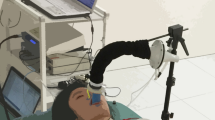Abstract
Two ways of rate control for diaphragm pacing are proposed. One is rate control using only the patients' body temperature (method I). The other is rate control by both the patients' heart rate and body temperature (method II). To test the effectiveness of these methods, a diaphragm pacemaker which can be controlled by both heart rate and body temperature has been developed. It was applied to nine mongrel dogs. The pacing rate is controlled by atrial blood temperature (method I) or by both heart rate and temperature (method II). The animal's metabolism was elevated by the administration of a pyrogenic drug. It was found that method I is not suited to rapid changes in metabolism; however, it is useful in extreme metabolic elevation. An animal's metabolism was supported by using method II in all ranges of metabolism. This method proved more effective than method I for rate-responsive diaphragm pacing.
Similar content being viewed by others
References
Alt, E., Hirgstetter, C., Heinz, M. andTheres, H. (1986) Measurement of right ventricular blood temperature during exercise as a means of rate control in physiological pacemakers.Pace,9, 970–977.
Asmussen, E. andHemmingsen, I. (1958) Determination of maximum working capacity at different ages in work with legs or with the arms.Scand. J. Clin. Lab. Invest.,10, 67–71.
Astrand, P. O., Guddy, T. E., Saltin, B. andStenberg, J. (1964) Cardiac output during submaximal and maximal work.J. Appl. Physiol.,19, 268–274.
Bilgutay, A. M., Bilgutay, I. M., Garamella, J. J., Jensen, N. K., Schmidt, W. R., Lynch, M. F. andKelly, W. D. (1970) Augmented ventilation by synchronous phrenic nerve stimulation.Trans. Am. Soc. Artif. Int. Organs,16, 213–217.
Fearnot, N. E., Jolgren, D. L., Tacker, W. A., Nelson, J. P. andGeddes, L. A. (1984) Increasing cardiac rate by measurement of right ventricular temperature.Pace,7, 1240–1245.
Glenn, W. W. L., Hogan, J. F. andPhelps, M. L. (1980) Ventilatory support of the quadriplegic patient with respiratory paralysis by diaphragm pacing.Surg. Clin. North America,60, 1055–1078.
Hogan, J. F., Koda, H. andGlenn, W. W. L. (1989) Electrical techniques for stimulation of the phrenic nerve to pace the diaphragm: inductive coupling and battery powered total implant in asynchronous and demand modes.Pace,12, 847–853.
Hoshimiya, N., Takahashi, M., Handa, Y. andSato, G. (1976) Basic studies on electrophrenic respiration. Part 1—Electrophrenic respirator synchronised with phrenic nerve impulses.Med. & Biol. Eng.,14, 387–394.
Judson, J. P. andGlenn, W. W. L. (1968) Radio-frequency electrophrenic respiration.JAMA,203, 1033–1037.
Kaneko, S., Jacobs, G., Matsushita, S. andNose, Y. (1985) A new approach to respiratory assist for phrenic nerve paralysis.Trans. Am. Soc. Artif. Int. Organs,31, 301–304.
Kimura, M., Sugiura, T., Harada, Y., Hasegawa, T. andYoshimura, K. (1986) Addition to an RF-coupled phrenic nerve stimulator implant to provide outward transmission of body temperature.Med. & Biol. Eng. & Comput.,24, 659–661.
Kimura, M., Sugiura, T., Harada, Y., Hasegawa, T. andYoshimura, K. (1987) A heart-rate-responsive diaphragm pacemaker,25, 458–462.
Levassort, C. (1964) Action de quelques agents pharmacodynamiques hyperthermisants et hypothermisants sur le metabolisme de base du lapin.J. Physiol. Paris,56, 693–706.
Rowell, L. B., Marx, H. J., Bruce, R. A., Conn, R. D. andKusumi, F. (1966) Reduction in cardiac output, central blood volume, and stroke volume with thermal stress in normal men during exercise.J. Clin. Invest.,45, 1801–1816.
Saltin, B. andHermansen, L. (1966) Esophageal, rectal, and muscle temperature during exercise.J. Appl. Physiol.,21, 1757–1762.
Satoh, I., Hogan, J. F., Glenn, W. W. L. andFujii, Y. (1977) A demand diaphragm pacemaker.Trans. Am. Soc. Artif. Int Organs,23, 456–463.
Author information
Authors and Affiliations
Rights and permissions
About this article
Cite this article
Kimura, M., Sugiura, T., Fukui, Y. et al. Heart rate and body temperature sensitive diaphragm pacing. Med. Biol. Eng. Comput. 30, 155–161 (1992). https://doi.org/10.1007/BF02446125
Received:
Accepted:
Issue Date:
DOI: https://doi.org/10.1007/BF02446125




